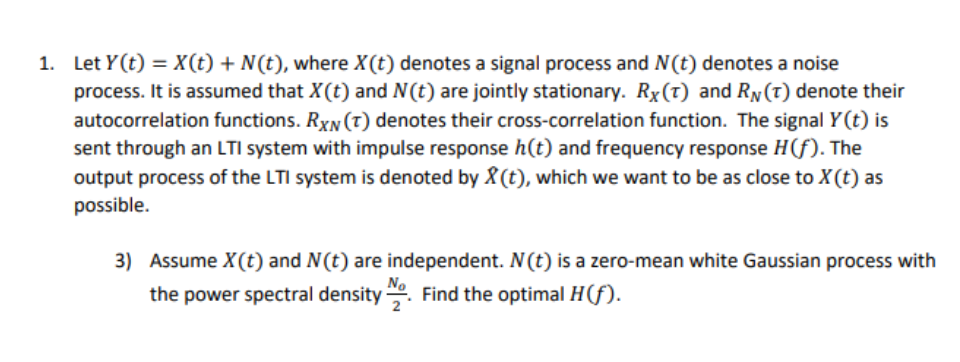1. Let Y(t) = X(t) + N(t), where X(t) denotes a signal process and N(t) denotes a noise process. It is assumed that X(t) and N(t) are jointly stationary. Rx(t) and RN(T) denote their autocorrelation functions. RXN (T) denotes their cross-correlation function. The signal Y(t) is sent through an LTI system with impulse response h(t) and frequency response H(f). The output process of the LTI system is denoted by X (t), which we want to be as close to X(t) as possible. 3) Assume X(t) and N(t) are independent. N(t) is a zero-mean white Gaussian process with the power spectral density . Find the optimal H(f).
1. Let Y(t) = X(t) + N(t), where X(t) denotes a signal process and N(t) denotes a noise process. It is assumed that X(t) and N(t) are jointly stationary. Rx(t) and RN(T) denote their autocorrelation functions. RXN (T) denotes their cross-correlation function. The signal Y(t) is sent through an LTI system with impulse response h(t) and frequency response H(f). The output process of the LTI system is denoted by X (t), which we want to be as close to X(t) as possible. 3) Assume X(t) and N(t) are independent. N(t) is a zero-mean white Gaussian process with the power spectral density . Find the optimal H(f).
Linear Algebra: A Modern Introduction
4th Edition
ISBN:9781285463247
Author:David Poole
Publisher:David Poole
Chapter4: Eigenvalues And Eigenvectors
Section4.6: Applications And The Perron-frobenius Theorem
Problem 69EQ: Let x=x(t) be a twice-differentiable function and consider the second order differential equation...
Related questions
Question
S

Transcribed Image Text:1. Let Y(t) = X(t) + N(t), where X(t) denotes a signal process and N(t) denotes a noise
process. It is assumed that X(t) and N(t) are jointly stationary. Rx(t) and RN(T) denote their
autocorrelation functions. RXN (T) denotes their cross-correlation function. The signal Y(t) is
sent through an LTI system with impulse response h(t) and frequency response H(f). The
output process of the LTI system is denoted by X (t), which we want to be as close to X(t) as
possible.
3) Assume X(t) and N(t) are independent. N(t) is a zero-mean white Gaussian process with
the power spectral density . Find the optimal H(f).
Expert Solution
This question has been solved!
Explore an expertly crafted, step-by-step solution for a thorough understanding of key concepts.
Step by step
Solved in 5 steps with 5 images

Recommended textbooks for you

Linear Algebra: A Modern Introduction
Algebra
ISBN:
9781285463247
Author:
David Poole
Publisher:
Cengage Learning

Linear Algebra: A Modern Introduction
Algebra
ISBN:
9781285463247
Author:
David Poole
Publisher:
Cengage Learning